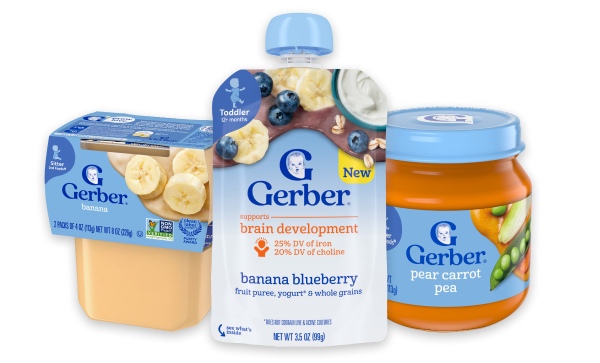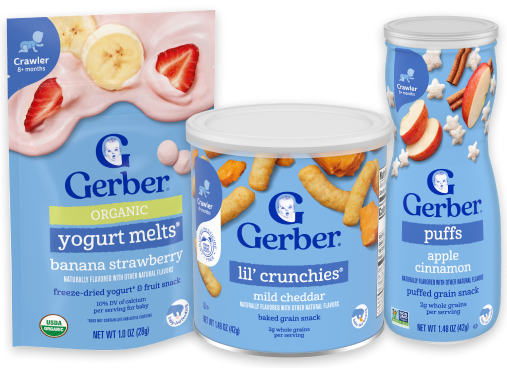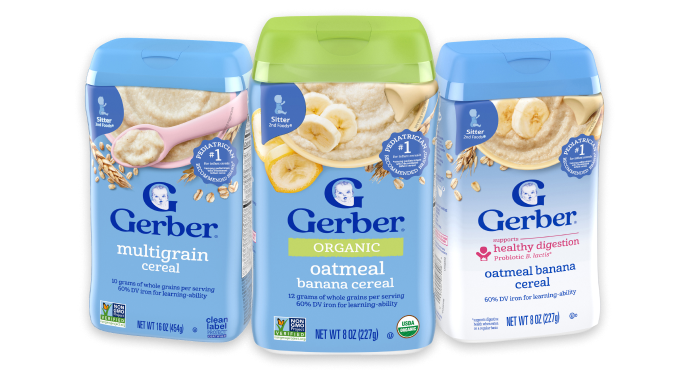Nutritious Gerber Toddler Foods
From ready to eat pouches to quick and easy meal options, Gerber foods for toddlers are made to our highest quality standards, using nutritious veggies, grains, meats and fruits to help provide toddlers with the nutrient-dense foods they need.
- Foods, textures, tastes and nutrition all specifically designed just for toddlers
- All Gerber Toddler Foods have portion sizes just for toddlers
- Convenience without compromising high quality ingredients and nutrient dense foods
- Pick-Ups™ developed to be baby-led friendly, helping little ones learn to safely self-feed
- Morning bowls with spoon hugging textures to help toddlers learn how to use spoons and utensils with less mess and frustration
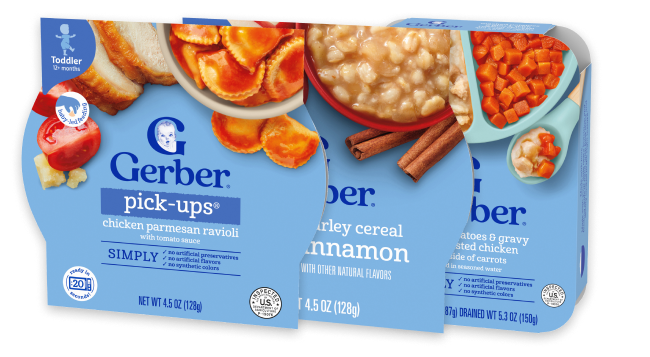
Role of Nutritious Gerber Toddler Foods in the Diet
Nutrients Toddlers Need
With carbohydrates from whole grains and veggies, protein from meats and legumes, and more, our foods provide nutrients toddlers need. Select varieties are also fortified with key nutrients for healthy growth and development – such as iron and vitamin C.
Help build a healthy eating pattern
Made with nutrient dense foods from all food groups - vegetables, fruits, whole grains, dairy, protein foods, and oils, Gerber can help your little one to build a healthy eating pattern as outlined by the Dietary Guidelines for Americans.
Align with FDA Sodium Guidance
The DGA recommendations for toddlers also include recommendations to limit foods high in sodium. Gerber foods for toddlers meet or exceed FDA’s voluntary sodium guidance for toddler foods.
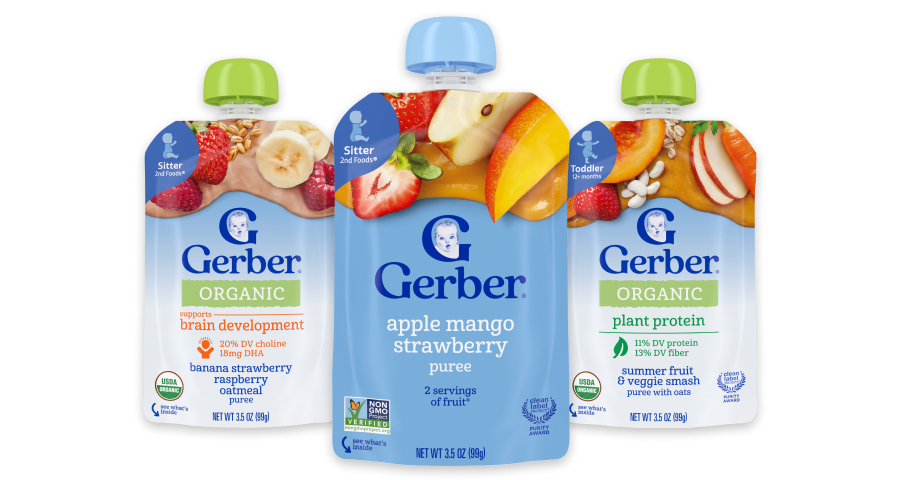
Pouches for Toddlers
Toddlers: 12 months+
Blends of nutrient dense fruits, veggies, grains and yogurts. Offers dietary variety and new tastes. Select choices provide key nutrients for toddlers such as vitamins A and C, potassium, protein and fiber.
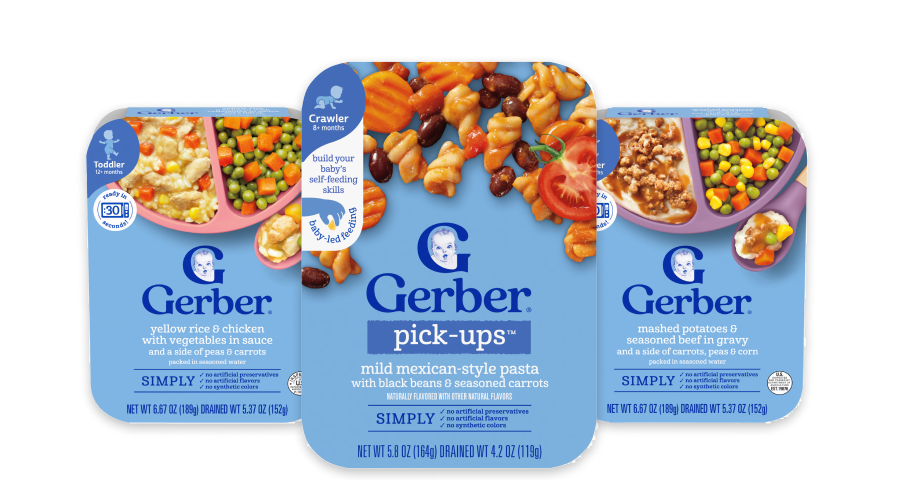
Toddler Entrees
Toddlers: 12 months+
Offers wholesome nutrition with none of the hassle. First, we combine our ingredients and seal them up tight. Then we slowly cook for just the right amount of time. No preservatives needed.
Select choices provide protein, vitamin A, whole grains, servings of veggies and more.

Pasta Pick-Ups®
Toddlers: 12 months+
Baby-Led friendly to encourage your little one’s independence while exploring new textures and developing feeding skills.

Breakfast Bowls
Toddlers: 12 months+
Oatmeal and multigrain breakfast choices made with whole grains and real fruit. Fortified with iron just for toddlers. No preservatives. Select varieties USDA certified Organic.

Fruit & Yogurt Blends
Toddlers: 12 months+
Goodness of real fruit and yogurt
Related Research and References
Gerber’s Feeding Infant and Toddlers Study (FITS) is the largest research study on infant and toddler nutrition in the world. Some key findings include:
FITS Finding
Gerber Toddler Foods can Help
FITS Finding
More than ¼ of children 6-48 months old do not eat a discrete serving of vegetables on a given day.
Gerber Toddler Foods can Help
Gerber offers many meal varieties that provide a serving of vegetables (¼ cup for toddlers).
FITS Finding
Most young children meet their daily protein needs, but poor-quality choices are common (chicken nuggets, hot dogs, etc.) with high sodium and saturated fat content.
Gerber Toddler Foods can Help
We offer meal varieties with animal protein from beef, chicken, and turkey or plant protein from chickpeas, quinoa, farro, lentils, oats, and barley.
FITS Finding
1/3 young children are not eating whole grains on a given day and may need 75% of their grains whole to help meet total fiber recommendation (for 1+ year olds).
Gerber Toddler Foods can Help
Our Breakfast Bowls provide 11g of whole grains and our Grain & Grow Morning Bowls provide 10-12g of whole grains.
FITS Finding
Vitamins A, C, and E are not identified as dietary gap nutrients from FITS but are essential for growth and development.
Gerber Toddler Foods can Help
Our Mashed Potatoes & Gravy with Roasted Chicken comes with a side of carrots that provide 20% DV of vitamin A for toddlers.
FITS Finding
By 2y of age, more than half of toddlers in the US have sodium intakes above the Daily Reference Value of 1,500mg
Gerber Toddler Foods can Help
Gerber meal options and sides meet the FDA sodium guidance.
Answers to Top Parent Questions
How can parents help toddlers avoid picky eating behaviors?
- As a parent, it’s your job to offer healthy foods. It’s up to your child to decide how much and what they will eat from the choices you provide. Avoid the power struggles!
- Offering the same foods over and over may not feel productive, but keep in mind, Toddlers may need to try a food up to 10 times before they accept it.
- Talking to your Toddler about foods you see in the grocery store or how you prepare food while cooking can help familiarize them with new foods.
- Rejecting food may be your child seeking attention or trying to control the situation. Avoid this conflict by staying positive and encouraging during mealtime.
- Make food fun. Making faces with vegetables on a plate or stacking vegetables in a tower can add kid appeal.
- Think like a kid. Children have short attention spans. Limit mealtimes to 20 to 30 minutes to help focus attention on eating. If they're not done eating in a reasonable amount of time, remove the food and have them move along with their day.
- Toddlers may be more interested in foods they can feed themselves.
Overall, a positive, enthusiastic attitude, praising your child for trying new foods, giving small token rewards like a sticker and reading food-themed books can help encourage your child to accept a new food.
How can parents help reduce mealtime stress and struggles?
Set the Stage
- Create a calm environment during mealtime by turning off the TV.
- Keep their tray simple by limiting the amount of bowls, spoons, and cups.
- Use familiar objects at the table—seeing the same bib, bowl, and utensils is comforting.
- Sit down at the table to eat as a family and include your child in the conversation.
Minimize Mealtime Stress
- Serving smaller-sized portions (1 to 2 tablespoons) is the way to go—large portions may overwhelm your child.
- Give them time to chew, swallow, and even play a bit with new food. Playing with food is part of learning about it, which helps your child feed themselves. Rushing your child takes the fun out of eating and adds stress.
- Embrace the mess! It will make the feeding experience more pleasant for you and your toddler. Let them explore even if it does get messy—Toddlers often need to look at, touch, smell, and taste a food before eating it.
- Patience is key. If your Toddler rejects a food, it might just be that they don’t recognize it. Children can often be “neophobic,” meaning they’re afraid of anything new and prefer eating foods they’re used to. Try not to get frustrated—instead of giving up on a rejected food, prepare it in a different way and offer it again.
- Serve a variety of healthy foods, and set a good example by eating them yourself. When your Toddler sees mom, dad or their siblings eating a nutritious food, they may be more willing to try it.
- Include a food they're used to in their meal, and then let your child choose if they want to try the other foods on their tray. Don’t prepare a separate meal—it could encourage your little one to continue this type of behavior at mealtime.
- Pay attention to your Toddler's hunger and fullness cues. Your role is to decide what foods to offer and when to offer them, but let your child decide whether to eat and how much to eat.
- Let your Toddler pick out a fruit or veggie at the grocery store, and then let them help you prepare it. Children are more likely to try foods they help prepare.
- Don’t bribe them with sweets. This teaches them that some foods are desirable while others aren’t.
- Be realistic. Your child may never love Brussels sprouts, but you can help them learn the joy of trying new foods at the dinner table.
It’s not uncommon for Toddlers to resist eating certain foods or only want to eat a couple of foods for a period of time. During Toddler years, it’s more important to focus on their eating pattern over several days instead of meal-by-meal.
